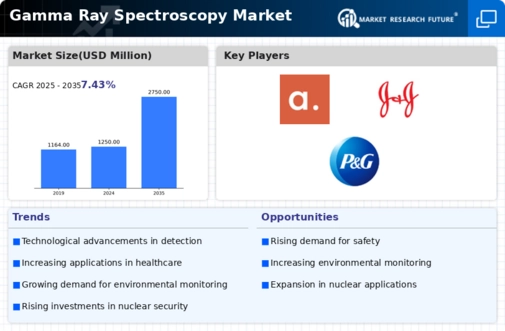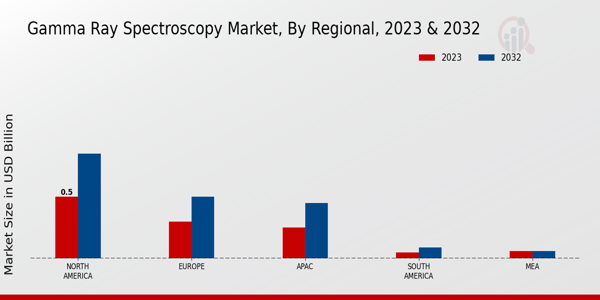Market Growth Projections
The Global Gamma Ray Spectroscopy Market Industry is projected to experience robust growth over the next decade. With an estimated market value of 1250 USD Million in 2024, it is anticipated to reach approximately 2750 USD Million by 2035. This growth trajectory suggests a compound annual growth rate (CAGR) of 7.43% from 2025 to 2035. Various factors, including technological advancements, regulatory requirements, and expanding applications across sectors, are contributing to this upward trend. The market's expansion reflects the increasing importance of gamma ray spectroscopy in diverse fields, including nuclear energy, healthcare, and environmental monitoring.
Growing Demand for Nuclear Energy
The Global Gamma Ray Spectroscopy Market Industry is experiencing a surge in demand due to the increasing reliance on nuclear energy as a sustainable power source. Countries worldwide are investing in nuclear power plants to meet energy needs while reducing carbon emissions. For instance, the International Atomic Energy Agency reports that nuclear energy could provide up to 25 percent of the global electricity supply by 2050. This trend necessitates advanced gamma ray spectroscopy for monitoring and safety assessments, contributing to the market's projected growth from 1250 USD Million in 2024 to 2750 USD Million by 2035.
Advancements in Detection Technologies
Technological innovations in detection methods are significantly influencing the Global Gamma Ray Spectroscopy Market Industry. The development of high-resolution detectors and portable spectrometers enhances the accuracy and efficiency of gamma ray measurements. For example, advancements in semiconductor detectors have improved energy resolution, allowing for more precise identification of isotopes. These improvements are essential for applications in environmental monitoring, nuclear security, and medical diagnostics. As these technologies evolve, they are expected to drive market growth, with a projected CAGR of 7.43% from 2025 to 2035, reflecting the increasing adoption of sophisticated detection systems.
Environmental Monitoring and Protection
Environmental monitoring is becoming increasingly crucial, influencing the Global Gamma Ray Spectroscopy Market Industry. The need to assess and manage radiation levels in the environment is driven by concerns over nuclear waste, mining activities, and natural background radiation. Governments and organizations are investing in gamma ray spectroscopy to monitor environmental radiation and ensure compliance with safety standards. For example, the U.S. Environmental Protection Agency employs gamma ray spectroscopy for assessing radiation levels in various ecosystems. This growing focus on environmental protection is likely to propel market growth, as industries adopt advanced spectroscopic methods to address these challenges.
Regulatory Compliance and Safety Standards
The Global Gamma Ray Spectroscopy Market Industry is significantly influenced by stringent regulatory compliance and safety standards across various sectors. Governments and international bodies are implementing regulations to ensure the safe handling of radioactive materials and the protection of public health. For instance, the U.S. Nuclear Regulatory Commission mandates regular monitoring of radiation levels in nuclear facilities, which necessitates the use of gamma ray spectroscopy. This regulatory landscape compels industries to invest in advanced spectroscopic technologies, thereby driving market growth as organizations strive to meet compliance requirements and enhance safety protocols.
Rising Applications in Medical Diagnostics
The application of gamma ray spectroscopy in medical diagnostics is expanding, thereby impacting the Global Gamma Ray Spectroscopy Market Industry positively. Techniques such as Positron Emission Tomography (PET) utilize gamma ray detection to provide critical insights into metabolic processes and disease states. The increasing prevalence of chronic diseases and the demand for early diagnosis are propelling the adoption of these technologies in healthcare settings. As healthcare providers seek to enhance diagnostic capabilities, the market is expected to witness substantial growth, contributing to the overall increase in market value from 1250 USD Million in 2024 to 2750 USD Million by 2035.













